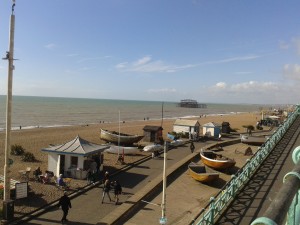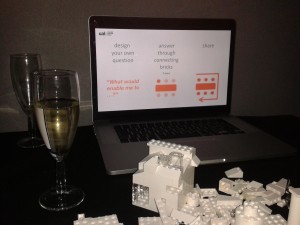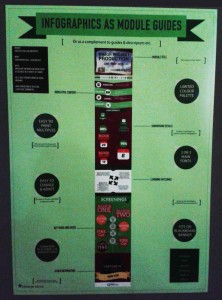It’s been a while since our last post, but we’re back with a review of Writing PAD’s recent trip to the seaside…

The HEA Arts & Humanities conference took place earlier this month in sunny and sparkling Brighton. I was there to present on behalf of De Montfort University and Writing PAD: thanks to those who gave encouraging feedback! The slides are available on my Slideshare (see below), and you can read the abstract here.
It’s very hard to sum up such a rich and varied couple of days in a blog post, but here are my highlights…
Kirsten Hardie from Arts University Bournemouth opened the conference with a typically colourful and quirky presentation focussing on object-based learning, role play and student-centred activities: crossing disciplines, taking risks and taking a playful and disruptive approach to teaching in Graphic Design. Her work captures the hands-on engagement and creativity that we aspire to in our Writing PAD sessions at DMU. You can read more about her work with object-based learning here – decorative toilet brush anyone?
One of the most memorable activities of the conference was the Contemplative pedagogies – collective/co-mindfulness as pedagogic space session (you will need to scroll down to find the abstract) run during the evening by Pratap Rughani and Graham Barton from University of the Arts London. We were asked to consider a question (research-based or personal), and use the white and transparent lego bricks to construct the answer. This was an interesting twist on the Lego Serious Play approach, the lack of colour choice meaning that the focus was purely on structure: a surprisingly effective route to reflection.

The presentation that really chimed with the visual perspectives on student writing put forward by Writing PAD was the 5 minute Ignite session on The Collage Workshop: Exploring images as argumentative tool (again, you will need to scroll down to find the abstract) by Renee Tobe from University of East London and Willem de Bruijn from Arts University Bournemouth. The idea put forward was that images can not only be a starting point for the content of an essay, but that they can be used in a much deeper way in terms of constructing an argument and developing a structure – very intriguing and relevant to our work.
The second keynote by Jonathan Worth from Newcastle University Open Lab is very hard to sum up in a few lines: he talked about not just ‘Teaching with‘ the digital, but ‘teaching of the digital.’ Jonathan discussed his #Phonar global photography classes, Phonar Nation, an international initiative enabling young people to take part in their own representation as well as much, much more: hugely inspiring and thought-provoking. You can read more about his work on using the affordances of social media in teaching here.
Christopher Hall from Sheffield Hallam University presented a poster showing a way of using Infographics to replace a module guide, both within a Virtual Learning Environment, and as hard copy. A great way of clearly communicating module content in a concise, engaging and visual way: an idea that has the potential to transform the way we communicate with students.

Conference presentations and more information, including abstracts and biographies of speakers are available via the HEA website and you can follow the conversations about the event at #HEAArts16.
Coming up we will have new workshops to share, plus more reports from Writing PAD on the road…
Julia
[…] My first taste of a mindful activity combined with a tactile approach was at a session run by Pratap Rughani and Graham Barton at the HEA Arts & Humanities conference back in 2016. This contemplative pedagogies workshop […]